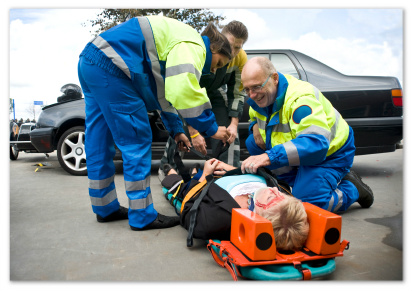
It's great that you've made the decision to become an Emergency Medical Technician, but now, the backbreaking work gets under way. And unfortunately, the solutions to oft-asked inquiries aren't easy to come by.
How exactly do I get educated to become an Emergency Medical Technician, anyhow? How do I ascertain what program to apply to, or what requirements programs have in place?
Is there a minimum age prerequisite? Are there specific recognitions which are obligatory?
The truth is that every single school (and every single state) has their own checklist of requirements that they're seeking in a student. Therefore, the applying procedure can change from program to program.
With that explained, there are a few standard prerequisites that are already in effect. Here in this article, we'll go over these requirements in hopes of breaking down the EMT training procedure, which we know can appear a little bit intricate.
First, let's start with just the fundamentals. Though every program might be relatively different, in most cases, you must be eighteen years old to apply to an EMT training school.
Although you are required to be eighteen, you are not required to hold a college degree. Among one of the excellent aspects of becoming an EMT is that the profession of an Emergency Medical Technician does not call for a lot of training or experience. While various jobs typically may require you to hold various degrees, anytime you apply to an EMT training program, you only need to have a high school diploma or GED.
With that stated, you will certainly also need to have an authentic vehicle drivers license. And with the basic EMT job description requiring EMTs to perform CPR on individuals not able to breathe on their own, you'll also need to hold CPR certification at the Healthcare provider level.
Individuals applying to EMT classes will have to be able to read at a 10th grade level or higher, too. Several programs, in their effort to make certain their students meet their standards, will require that you take specified assessment exams (like COMPASS, for example).
It's also very important to bear in mind that as an EMT, you will frequently be in connection with a wide range of individuals-- both at the scene of an accident and inside of medical centers or other healthcare facilities. That means that you are counted on to be in good overall health.
To demonstrate that, you'll probably be asked to provide a record of a recent physical examination. Coupled with the physical, you'll have to offer evidence that you've received various immunizations. The list of mandatory vaccinations may vary to an extent, but will likely include proof of a recent Tuberculosis immunization, along with Hepatitis and Measles, Mumps and Rubella.
As soon as you're affirmed into an EMT school, you can expect to get around 100 hours of specialized training. While training is typically done in the classroom, you might also get your education in the field (on an ambulance, as an example) or in clinical settings (inside a clinic or medical facility).
In comparison, though EMT training can last approximately one hundred hours, individuals interested in becoming a paramedic can expect to get 1,300 hours of training.
When you graduate from your EMT training program (which will take anywhere from 3-6 months on average), you'll most likely want to take the NREMT exams.
The NREMT certifies EMT and paramedics on a nationwide level. While getting national certification by itself doesn't authorize one to truly work in the state of their choice, the intention of the NREMT is to ensure that that all EMS workers responsible for healing patients are capable to work.
The NREMT exams consist of a computer adaptive test and a skills test. After you pass the examinations, (and are ready to operate as an EMT), you'll then want to apply for a state EMT license.
To receive a state license, you'll want to apply to the EMS agency in your area. The application process can often be as simple as providing some required documents to the agency for evaluation, or as complex as taking an obligatory state test to secure your license.
When both your EMT certification and state license have indeed been acquired, you're then allowed to hunt for a job and ultimately get employed as an Emergency Medical Technician.
If you already understand everything there is to know about EMT training, and are now interested in learning more on how to become a paramedic, be sure to visit http://paramedictrainingspot.com!
How exactly do I get educated to become an Emergency Medical Technician, anyhow? How do I ascertain what program to apply to, or what requirements programs have in place?
Is there a minimum age prerequisite? Are there specific recognitions which are obligatory?
The truth is that every single school (and every single state) has their own checklist of requirements that they're seeking in a student. Therefore, the applying procedure can change from program to program.
With that explained, there are a few standard prerequisites that are already in effect. Here in this article, we'll go over these requirements in hopes of breaking down the EMT training procedure, which we know can appear a little bit intricate.
First, let's start with just the fundamentals. Though every program might be relatively different, in most cases, you must be eighteen years old to apply to an EMT training school.
Although you are required to be eighteen, you are not required to hold a college degree. Among one of the excellent aspects of becoming an EMT is that the profession of an Emergency Medical Technician does not call for a lot of training or experience. While various jobs typically may require you to hold various degrees, anytime you apply to an EMT training program, you only need to have a high school diploma or GED.
With that stated, you will certainly also need to have an authentic vehicle drivers license. And with the basic EMT job description requiring EMTs to perform CPR on individuals not able to breathe on their own, you'll also need to hold CPR certification at the Healthcare provider level.
Individuals applying to EMT classes will have to be able to read at a 10th grade level or higher, too. Several programs, in their effort to make certain their students meet their standards, will require that you take specified assessment exams (like COMPASS, for example).
It's also very important to bear in mind that as an EMT, you will frequently be in connection with a wide range of individuals-- both at the scene of an accident and inside of medical centers or other healthcare facilities. That means that you are counted on to be in good overall health.
To demonstrate that, you'll probably be asked to provide a record of a recent physical examination. Coupled with the physical, you'll have to offer evidence that you've received various immunizations. The list of mandatory vaccinations may vary to an extent, but will likely include proof of a recent Tuberculosis immunization, along with Hepatitis and Measles, Mumps and Rubella.
As soon as you're affirmed into an EMT school, you can expect to get around 100 hours of specialized training. While training is typically done in the classroom, you might also get your education in the field (on an ambulance, as an example) or in clinical settings (inside a clinic or medical facility).
In comparison, though EMT training can last approximately one hundred hours, individuals interested in becoming a paramedic can expect to get 1,300 hours of training.
When you graduate from your EMT training program (which will take anywhere from 3-6 months on average), you'll most likely want to take the NREMT exams.
The NREMT certifies EMT and paramedics on a nationwide level. While getting national certification by itself doesn't authorize one to truly work in the state of their choice, the intention of the NREMT is to ensure that that all EMS workers responsible for healing patients are capable to work.
The NREMT exams consist of a computer adaptive test and a skills test. After you pass the examinations, (and are ready to operate as an EMT), you'll then want to apply for a state EMT license.
To receive a state license, you'll want to apply to the EMS agency in your area. The application process can often be as simple as providing some required documents to the agency for evaluation, or as complex as taking an obligatory state test to secure your license.
When both your EMT certification and state license have indeed been acquired, you're then allowed to hunt for a job and ultimately get employed as an Emergency Medical Technician.
If you already understand everything there is to know about EMT training, and are now interested in learning more on how to become a paramedic, be sure to visit http://paramedictrainingspot.com!


 RSS Feed
RSS Feed